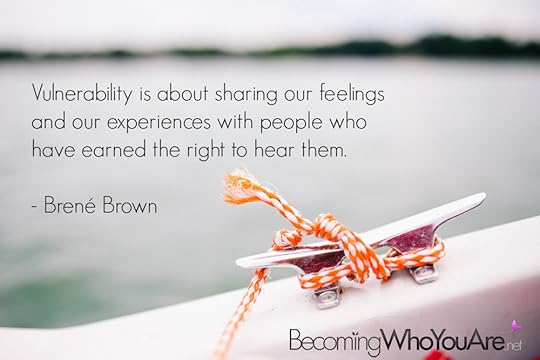5 Things Authenticity is Not
Listen to this post here:
Authenticity has become a buzzword in our culture and, consequently, there are a lot of misconceptions around what authenticity really means and what it looks like. Sometimes it’s just as helpful to be able to define what something is not as it is to define what something is, so here are five key things that authenticity is most definitely not:
1. Authenticity is not radical honestyOne of the biggest misconceptions about authenticity is the idea that if we’re truly being authentic, then we’re being 100% honest 100% of the time. This isn’t authenticity, it’s Radical Honesty which is quite a different deal. Radical Honesty is based on the idea that most of the stress and pain we experience is caused by lying, so if everyone were more honest about their thoughts and judgements about other people, we’d all be a lot happier.
From what I’ve read about Radical Honesty, it appears to be authenticity minus empathy. Personally, I’ve found that cultivating empathy and understanding towards other people encourages intimacy, rather than being brutally honest. I’ve felt a lot safer being myself with other people when I know that my “self” is going to be received with understanding and acceptance, rather than judgement and shaming.
Just because we have a thought doesn’t mean we need to share it “as is”. When we’re honest and take into consideration the impact of our words, we create a safe space for self-expression for ourselves and for others.
2. Authenticity is not about showing up the same way in all situations.When I first started exploring the idea of authenticity, I thought that being “authentic” meant behaving in exactly the same way in all situations.
I was wrong.
An important part of reconnecting with our authentic selves is reconnecting with our boundaries.
Click To Tweet - Powered By CoSchedule
Having healthy boundaries means we don’t behave the same in all situations. We’re still the same person, but we show more or less, or different sides of ourselves depending on who we’re interacting with and what our relationship is to them.
For example, when I interact with clients, I have different kinds of conversations with them than I do with friends or my husband. When I’m in a client session, the focus is on them, not on me. I don’t spend the first half of the session talking about my latest travel plans or what I did at the weekend, because that would be disrespectful. When I’m catching up with friends, however, it would be kind of weird if I approached our conversations in the same way I do with clients.
Authenticity is about being the same person in all situations, but we naturally show up in different ways and reveal different sides of ourselves depending on the context of a particular situation.
3. Authenticity is not necessarily revealing everything to everyone.This is another boundaries issue, and it’s one of my pet peeves. Having grown up in an environment with boundaries that were shaky at best, part of becoming more of who I am has been acknowledging that I only want to be around people who show empathy and respect for themselves and other people by honouring the boundaries of our relationship.
As I wrote about in this blog post on vulnerability versus over-sharing, revealing super intimate details about ourselves before the relationship is ready is not a gateway to greater intimacy in general, it’s actually a barrier.
In certain situations, such as coaching and therapy, revealing is an integral, even necessary, part of the process. That works, because there’s a mutually understood agreement about what our time together is for. Revealing everything to everyone becomes an issue in our day-to-day relationships when there isn’t that mutually understood (and earned) agreement.

The fact is that we don’t need to reveal everything about ourselves to everyone in order to be authentic. What is more authentic is actually being prudent about who we share the more personal parts of ourselves with (I always feel super honoured that my clients have chosen to work with me for this very reason).
When we make a practice of sharing everything with everyone, we not only risk repelling people who have healthy boundaries, but we also open ourselves up to the risk psychological and emotional harm from people who haven’t earned the right to an intimate relationship with us.
4. Authenticity is not a contest.There are no prizes for being “the most authentic” person in a group, and it’s not a means to feel superior over others. Authenticity has become a bit of a buzzword in our society, and the darker side of that is that a few people have started to use it as a judgement. I don’t often receive angry/provocative emails but on the occasions I have, the most common jibe I hear is “If you were really authentic, you’d do XYZ”.
Needless to say, this completely misses the point of what authenticity is: it’s behaving in a way that is true to our own needs, preferences, and values. We are the best judge of what authenticity looks like for us, and no one else has any business judging us based on their evaluation of how authentic we’re being or not.
5. Authenticity is not a destination.What authentic looks like will change from one year to the next—hell, even one day to the next. In Spanish, there are two forms of the verb “to be”. On a very general level, one type, “estar”, expresses temporary states, such as physical feelings, emotions, and locations, while another, “ser” expresses more permanent states, such as nationality and gender.
The way I think about being authentic is that it is “being” in the “estar” sense. We don’t work at our authenticity and then wake up one day to discover (tada!) we are finally authentic. It’s a process, and one that is happening with each moment-to-moment decision we make.
While authenticity can feel like hard work at times—and during those times, we might wish for a permanent solution—the fact that it’s a process is actually a great thing. It means we have the power to create an authentic future, whatever has happened behind us. It means we have the choice to decide how we show up today, tomorrow, and beyond, and show up in a way that feels more authentic to us. Ultimately, it means that it’s never too late to become who we are.
Let’s flip this around: What *is* authenticity to you? Leave a comment and let me know.
P.S. The power of vulnerability & shift happens
Thanks for reading. If you know someone who might be interested in this post, please share it using the buttons below.
Get the free ebook “The 5 Most Common Blocks to Authenticity… and How to Overcome Them” plus weekly updates, product discounts and much more:
Image: Sylwia Bartyzel
The post 5 Things Authenticity is Not appeared first on Becoming Who You Are.








 CommentsGreat article indeed, like a very nutritionally dense meal. Not ... by BruceThanks for this great post, Hannah! I seem to have been talking ... by Andy
CommentsGreat article indeed, like a very nutritionally dense meal. Not ... by BruceThanks for this great post, Hannah! I seem to have been talking ... by Andy



